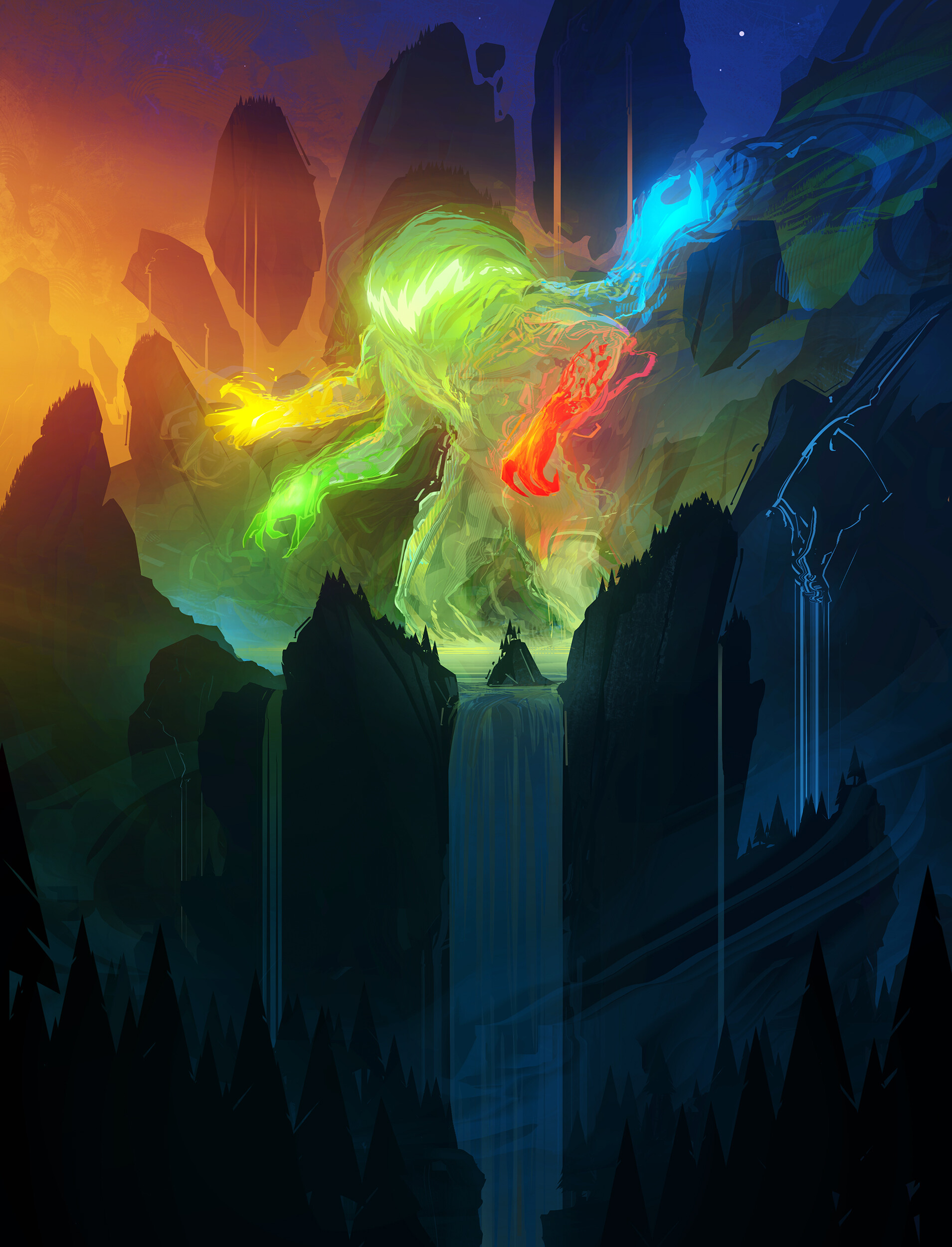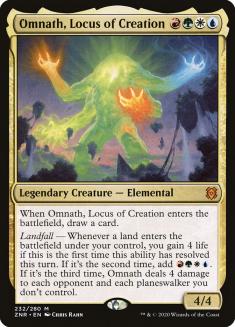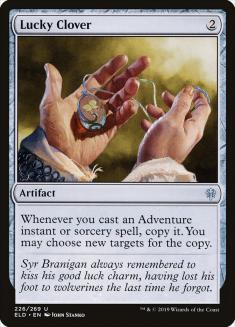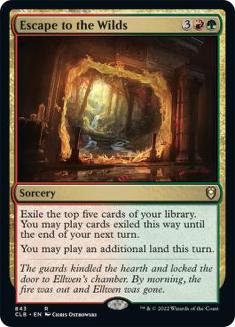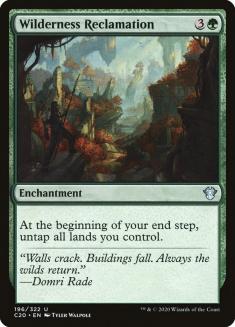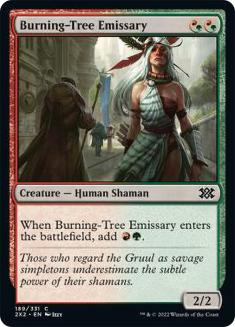Welcome to another edition of Fact or Fiction! Today, Andrew Elenbogen, Ari Lax, and Carmen Handy give their takes on five statements about the surprise October 12 Banned & Restricted Announcement. Don’t forget to vote for the winner at the end!
1. Banning Omnath, Locus of Creation in Standard and suspending it in Historic was a good decision.
Andrew Elenbogen: Fact. This is the easy one. Omnath, Locus of Creation is a completely ridiculous card. Much like Oko, Thief of Crowns, it could be made worse in multiple ways and still be at a Constructed power level. A 2/2 Omnath that doesn’t deal damage on the third land entering? Yeah, that card is still quite playable. There’s no reason for Standard to contain a 4/4 for four mana that draws a card and gains four life a turn and makes four mana on the regular.
Omnath is the best card against aggro, the best card in a ramp mirror, and probably the best card against any other macro-archetype that cropped up in the future. Currently, however, those other macro-archetypes do not exist because Omnath has pushed them out entirely.
This is all not to mention the fact that Omnath decks typically create ridiculous battlefields that are hard to parse for even seasoned players. The viewing experience of Magic matters and this card substantially contributes to degrading it. Omnath forces players to consider otherwise corner-case mechanisms such as the Arena clock or running out of library.
While this can be an engaging novelty on occasion, clock and deck management should not be major components of Magic’s premier format. Some of the ban decisions Wizards of the Coast (WotC) has made recently have seemed very close to me, but this one is just not. Good riddance.
Ari Lax: Fact. This can only be Fiction if your argument is why this didn’t happen two weeks ago.
Mark Rosewater uses a line that Magic releases really act as new but similar games, not just new pieces for the same game. Omnath and several other cards feel like distinct failures to design for the goal of making that new release a good game, but instead designing the most readily exciting pieces for the old game.
Stop printing spells that immediately refund their cost. Stop printing Mana Flares that immediately refund their cost. Stop printing Mana Flares that cantrip and gain life and refund their cost and attack and block. Stop printing cards that literally perform every resource and positioning role in a game. Stop trying to print queens and queen-pluses, and print more pawns and bishops.
Carmen Handy: Fact. Love to have Omnath get deleted from Magic. It’s one of the most truly “free” cards we’ve ever seen — replacing the card invested as well as the mana, with a ton of upside if it isn’t answered. Talking about why Omnath is strong is a bit redundant at this point and I’m interested to put it to bed, but I am excited to see what its removal from these formats can open up.
2. Banning Lucky Clover in Standard was a good decision.
Andrew Elenbogen: Fact. This is the answer today that I am the least certain about, but I am going with Fact. Much like Omnath, Lucky Clover degrades the Magic viewing experience by creating ludicrous game states. But the card asks a lot more from you than Omnath does, and it is far more exploitable. It can only be played with a specific combination of cards that sacrifices its entire sideboard in order to make the engine work.
Moreover, any deck that pressures Adventures without falling prey to its limited suite of interaction would legitimately be favored against it. If such a deck existed, Adventures would be unable to adapt due to its lack of sideboard. If the de facto best deck has at least one bad matchup, Standard is likely to remain a reasonably healthy place.
The problem is that I’m not sure that any aggressive deck avoids falling prey to Bonecrusher Giant and Brazen Borrower right now. Embercleave is vulnerable to both these cards, and the formula for most red decks recently has been 56 blanks and 4 Embercleave. White aggro is not playable right now due to the rotation of Venerated Loxodon, and Winota, Joiner of Forces lines up poorly against Brazen Borrower.
While future sets might well provide the tools to handle Temur Adventures, those tools do not exist right now. That means refusing to ban Lucky Clover would result in months of a format dominated by Temur Adventures and its ridiculous battlefields. That just does not seem acceptable, so the Clover’s luck had to run out.
Ari Lax: Fact. I think this one has been secretly pending for a while now. Theros Beyond Death Standard was a weird mess of miserable mana and card doubling effects somehow all cancelling each other out to make a metagame, like Fires of Invention and Wilderness Reclamation, and since then we have seen those cards fall to bans like dominoes as more printings or bannings set the next one up to crash a format.
Lucky Clover was the least likely card from that era to get better over time as it references a specific mechanic, but Temur Adventures being competitive in that field says a lot. Lucky Clover is also an artifact without good easy-to-include answers in the format, costed low enough the window to preemptively protect against it often doesn’t exist, and only asks that you play other good cards. That’s all the right boxes to check for a ban and anything that gets the format further out of Throne of Eldraine‘s shadow is good to me.
Carmen Handy: Fact. The games where Four-Color Adventures had Lucky Clover were so close to unwinnable, because the card was always worth more than was invested into it. It was frequently going to generate ten to twenty mana worth of spells in a game, as well as a ton of cards worth of value, all for two mana. The mana cost was too low, and it made games incredibly repetitive. The mechanics of adventure creatures also made it difficult to create meaningful counterplay in the face of Bonecrusher Giant, Lovestruck Beast, and Fae of Wishes.
3. Banning Escape to the Wilds in Standard was a good decision.
Andrew Elenbogen: Fiction. Urban Evolution did nothing wrong. It is true that all Omnath decks happened to play Escape to the Wilds, but I do not think this implies that it is too strong. Taking a turn off from making plays to draw cards is honestly a breath of fresh air. These days, most Constructed-playable expensive cards generate a large amount of advantage without ever taking a turn off from making plays on the battlefield, such as Nissa, Who Shakes the World.
The only reason Escape to the Wilds has seemed busted is because Omnath and Lotus Cobra do a good job of turning that five-mana investment into a zero-mana investment and therefore a broken card. But, as is usually the case in Magic, the problem there lies in the fast mana, not the payoff.
The strongest argument I see for banning Escape is that people are just tired. They are tried of endless broken ramp decks, the kind that have dominated Standard for two straight years. As a result, these decks just need to be wiped off the map, even if that means banning an innocuous card. I am receptive to that argument, although I think it is unlikely that ramp would dominate without Omnath or Lucky Clover.
But let’s say I’m wrong, and ramp does, once again, rise to the top after losing these two cards. Does anyone seriously think that rise would be due to Escape rather than Lotus Cobra? When every expensive card generates advantage every turn, casting them two turns ahead of schedule is game-winning. Lotus Cobra will always make that possible, Escape or no Escape.
Having a powerful bridge card is good for ramp decks, but it is good in a fair and fun way as long as that card costs a full turn of investment. If I were taking a scorched-earth approach to ramp decks, I would have banned Lotus Cobra. If It were using a scalpel, I would ban neither. Either way, I would have left the unique Gruul card draw spell alone.
Ari Lax: Fiction. I’m glad WotC decided to give everyone forced to play Omnath four free rare wild cards for their suffering.
Escape to the Wilds is a five-mana sorcery with no immediate battlefield impact and that requires a specific deck setup to exploit. It certainly plays well with cheaper Adventure spells on a more powerful expensive creature and with modal DFCs, but this is on the same level as “Baneslayer Angel was used as a primary threat in Jace, the Mind Sculptor decks, so we are banning both cards.”
Carmen Handy: Fact….? I guess? It feels like Escape to the Wilds was simply WotC working to put the nail in the coffin for an archetype they do not want to exist anymore. If the goal is to completely eliminate grindy never-end-the-game decks from Standard, banning Escape to the Wilds accomplishes that goal. If that wasn’t explicitly what they were going for, then the ban seems unnecessary, as Omnath’s and Clover’s bannings mostly cover Escape to the Wilds’s space in the format.
4. Banning Teferi, Time Raveler and Wilderness Reclamation in Historic was a good decision.
Andrew Elenbogen: Fact. Let me start by discussing Wilderness Reclamation. This card was incredibly strong when it was last legal in Historic and I am skeptical that would change. The ramp cards in the format are still very strong, Uro, Titan of Nature’s Wrath remains legal, and the deck’s strategy is fundamentally powerful. It is a highly interactive combo deck with a kill that is nearly impossible to stop.
I do not think even top-tier Historic archetypes like Mono-Red Goblins or Jund Sacrifice can compete with that combination. Wilderness Reclamation forces every deck to have hand disruption or stack interaction. That is just not conducive to a healthy format. Thus, due to its raw power level and effect on the metagame, Reclamation needs to stay gone.
Teferi, Time Raveler is a card that I honestly think is fine in Historic on power level. Azorious Control decks are not playable right now, and it seems unlikely that will become playable any time soon. Boosting them with Teferi would be good for format diversity.
The problem with Teferi is that is a miserable card to play against. Part of why Magic is so fun is the timing aspect. Sometimes you need to cast spells on your own turn, sometimes you need to cast them in combat, and sometimes you need to cast them in your opponent’s end step. Teferi removes all that and, as long as it is on the battlefield, its controller gets to play around nothing. It also blanks an entire class of cards, interacting with them in the worst possible way.
Magic would be a better game if Teferi, Time Raveler was never printed and Historic is a better format without him.
Ari Lax: Fiction. I won’t claim to understand the format mission statement of Historic as more archival content is added to Arena, but as of today banning Wilderness Reclamation seems fine. The format is close enough to Standard from three months ago that, even if Wilderness Reclamation wasn’t absolutely dominant, it would be oppressive to a wide range of strategies.
Teferi is unfairly hated within the realm of competitive play. It does awkwardly hose niche strategies like Finale of Promise, but in non-rotating formats those usually deserve a hate card or wouldn’t even be good without Teferi around. Same with the bulky permanents Teferi bounce manages. Teferi pushes out heavy reliance on countermagic, something that often would beat up those exact strategies Teferi hoses even if it wasn’t around.
In high-tier matches, Teferi tried to balance Simic Flash and Temur Reclamation in Standard. He was definitely the good guy in both those situations and I would expect the same in Historic.
Carmen Handy: What? Why is this one question? Reclamation is Fact. Teferi, Time Raveler is Fiction. Wilderness Reclamation is the easiest mana-doubler to build around in the format. It was trivial to start a decklist with a pile of Wilderness Reclamations and Explores, and then let God figure out the rest.
Teferi, Time Raveler is a ban that I’ve been against since his suspension a few weeks ago. The powerful things that people are playing in the format are frequently going over the top of Teferi to the point that it strikes me as odd for him to be problematic to the format as a whole.
Especially with Field of the Dead decks gone, there isn’t some “play to perfect inevitability” archetype to pair Hallowed Fountains with. I’d imagine Teferi can actually give those decks a bit of help in a format where they’d otherwise struggle.
5. Unsuspending Burning-Tree Emissary in Historic was a good decision.
Andrew Elenbogen: Fact. Honestly, the fact that this card was ever suspended is laughable. If Gruul Aggro is the best deck in Historic, WotC should throw a party! Although, as I understand it, many Gruul decks chose to eschew Burning-Tree Emissary even then.
Since that time, Amonkhet Remastered, Jumpstart, and Zendikar Rising have all added multiple format-defining cards. As a result, I am skeptical that Gruul is going to be playable even with a free 2/2 in its arsenal. It just can’t compete with the likes of Collected Company; Thoughtseize; Muxus, Goblin Grandee; and Lotus Cobra.
This card should be unbanned for the same reason Black Vise was unbanned in Legacy in 2015 — it’s so underpowered relative to the format that keeping it banned is just embarrassing. I expect Burning-Tree Emissary to have about as much influence in Historic as Black Vise did in Legacy: few people will play it and those people will probably be wrong.
Ari Lax: Fact. They still let you play Muxus, Goblin Grandee in Historic. You are really going to try and say Burning-Tree Emissary isn’t okay if that card is?
Camen Handy: Fiction. Burning-Tree Emissary is the kind of card that can’t really make it to the decklist registration sheet without creating unsatisfying games of Magic. The entire premise of the card is that it’s ideally building a zero-mana Memnite.
In the later turns of the game, it’s a Runeclaw Bear (read: embarrassing), and in the early turns of the game, multiple copies of the card can just completely take the steam out of a game of Magic before it’s begun. Burning-Tree Emissary is one of the my least favorite cards to be added to the format via the Historic Anthologies and seeing it come off the Suspended List is incredibly disappointing.

